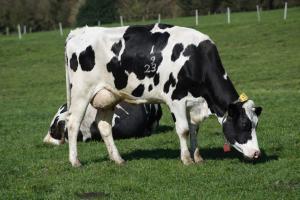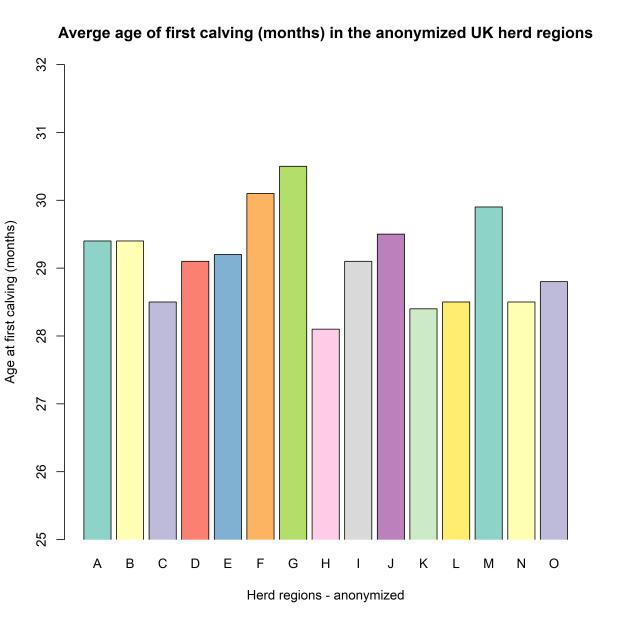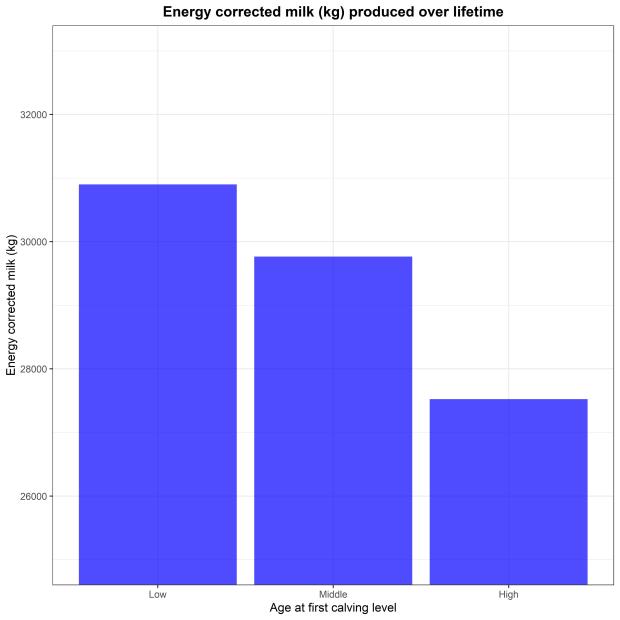Reduced age at first calving can increase lifetime performance by 13%
Date published:
Improving the genetics of your dairy herd is a key tool in maximizing the profitability and sustainability of dairy production.

Economically it has potential to deliver a 5 fold return on your investment. Replacement heifers are the main route to advance the genetic potential of the herd and in practice should be the best genetics on the farm. As an example, the Profitable Lifetime Index (£PLI) of the AFBI Hillsborough herd, which is in the top 1% of UK herds for £PLI (AFBI milking herd average £PLI is 330), is broken down by lactation number in Table 1. This trend of higher genetic merit in replacements is mirrored at a national level.
Table 1. £PLI by lactation number of the AFBI Dairy Herd
| Lactation Group | £PLI |
| 0 | 471 |
| 1st | 418 |
| 2nd | 345 |
| 3rd | 302 |
| 4th | 226 |
| 5th | 206 |
| >5th | 179 |
Previous research work has clearly shown the economic, land sparing and carbon footprint benefits of rearing heifers to join the milking herd at 24 months of age and realise their genetic potential. However a significant proportion of heifers still first calve well beyond 24 months of age. Increasing the average age at first calving in a 100-cow herd from 25 to 28 months increases the rearing cost by 18% which equates to an extra cost of ~£5800/year (for a typical 100 cow dairy herd).

A subset of data was selected for analysis comprising 2 million Holstein cows born after 2000 with age at first calving between 21 to 42 months. Cows were categorized based on their age at first calving into three levels; the low level had an age at first calving between 21 to 24 months, the middle level between 24 to 30 months, and the high level between 30-42 months (Table 2).
Table 2. Number of Holstein dairy cows used in the study at age at first calving levels
| Age at first calving level | Range of age at first calving (months) | Number of Holstein dairy cows |
| Low | 21 to 24 | 296,795 |
| Middle | 24 to 30 | 866,028 |
| High | 30 to 42 | 744,270 |
Key findings
- The average age at first calving in Northern Ireland was found to be 28.5 months, however it varied significantly across the regions of the UK (Figure 1) with averages per region ranging from 28.1 to 30.5 months.
- Cows in the low level (i.e. first calved between 21 and 24 months of age) produced an average of 30,901 kg milk (energy corrected) in their lifetime which is 1,137 and 3,570 kg more energy corrected milk than the average for cows in the middle and high level categories (Figure2).
- For every extra month to the age of first calving, there is an average decrease of 16 days in the cows productive life (months in milk) and a decrease of 0.225 kg/day of daily (energy corrected) milk production.

Age of first calving is a function of two key elements:
- Management and production system often referred to as the Environment effect
- Genetics
In order to understand the effect of currently existing breeding programs on the age of first calving, AFBI investigated the effect of £PLI on age at first calving. In this complex analysis using the UK wide dataset, cattle with higher £PLI reached the age at first calving sooner. As an example for every £10 increase in £PLI, age at first calving reduced by 3 days. This is positive news in that despite not being directly included in £PLI index currently, an improvement in £PLI is positively associated with a reduced age at calving.
Currently the genetic aspect of variation in age at first calving is not accounted for in breeding goals however AFBI are discussing this with possible partners as incorporation of ‘age at first calving’ will contribute to overall enhanced productivity and a reduced carbon footprint of dairy production.
Summary
Dairy heifers should be the best genetics on the farm and should be reared to enable them to realise their potential. Studies at research farms locally and globally have shown the clear benefits of calving heifers at 24 months of age. Measuring heifer growth enables producers to monitor performance and adjust nutrition and management accordingly to hit the growth targets to first calve at 24 months of age (further information at /publications/dairy-innovations-2018-profiting-afbi-research-booklet).
Hitting these targets will enable heifers to deliver of their genetic potential. Furthermore, the detailed analysis by AFBI of millions of lactation records from across UK commercial farms clearly supports these research findings, with heifers that calve at 21-24 age producing more energy corrected milk in their lifetime. Positively each unit increase in £PLI was also associated with a reduction in age at first calving highlighting the role of genetics which AFBI hope to explore further in future research projects.
Notes to editors:
AFBI is an arms-length body of DAERA delivering research and development, diagnostic and analytical testing, emergency response capability and expert scientific advice for DAERA and other government departments, public bodies and commercial companies in Northern Ireland, and further afield.AFBI’s Vision is “Advancing the Local and Global Agri-Food Sectors Through Scientific Excellence”.AFBI’s core areas:Leading improvements in the agri-food industry;Protecting animal, plant and human health;Enhancing the natural and marine environment.